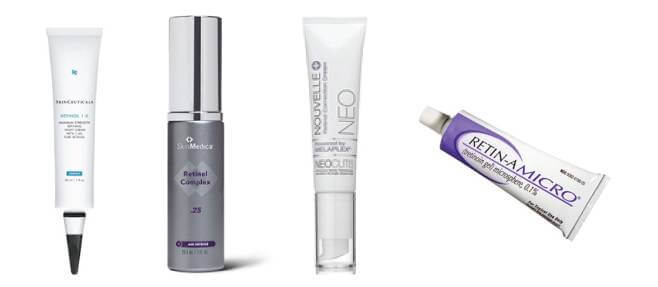Retinol vs. Retin-A: Here’s When to Use Each One

While retinol and Retin-A sound similar, these popular retinoids actually behave quite differently. They are both forms of Vitamin A, a proven skin care ingredient with the power to fight acne, improve the complexion, enhance skin firmness, and provide protection from skin damaging free radicals. There are, however, differences between Retinol and Retin-A in terms of their usage and efficacy.
Here’s a basic rundown on the major differences between retinol and Retin-A:
What Are Retinoids?
Both retinol and Retin-A are forms of retinoids, which are compounds that are derived from vitamin A. Retinoids have become one of the most popular skin care ingredients due to their ability to address multiple different types of common skin issues. Retinoids are great for exfoliating, the process of removing dead skin cells and other debris to unclog pores, making them a great tool for the fight against acne.
Retinoids have also been shown to speed up skin cell turnover (the creation of new skin cells) and stimulate the skin’s production of skin firming proteins like collagen and elastin. Indeed, continued usage of retinoids can help many common signs of aging like lines, wrinkles, and age spots. Users have reported significant improvements in skin tone, texture, and their overall complexion.
What is Retinol?
Retinol, sometimes referred to as Vitamin A1, is a natural form of Vitamin A. Retinol has been approved as an over-the-counter medication since 2019. It is found in skin creams and other skin care products that claim to boost collagen production, treat fine lines, reduce discoloration and smooth the skin.
Retinol doesn’t affect the skin directly. Rather, it gets converted into retinoic acid via enzymes found within this skin. Retinol is completely ineffective until this conversion process occurs. Both the timing and efficacy of this conversion can differ from person to person, so retinol may need up to 6 months before the user realizes results. However, retinol is gentle on the skin and the overall risk of side effects like dryness or irritation is low.
Since retinol is an OTC product, the ingredient is found in a variety of skin care products. It’s important to choose a product from a reputable brand to ensure the authenticity. When considering the purchase of retinol product, it’s important that Vitamin A is listed among the primary ingredients on the label. The packaging should also be opaque and air-tight to preserve the product’s effectiveness.
What is Retin-A?
Retin-A is the brand name for tretinoin, a prescription-based medication that has been approved by the FDA to treat acne. Other brands of tretinoin include Atralin, Avita and Renova. Retin-A, Atralin and Avita are primarily prescribed to treat acne, while Renova is generally used to fight wrinkles and skin discoloration.
Just like retinol, Retin-A is a form of vitamin A that helps promote skin renewal. By eliminating the buildup of dead skin cells, the medication unclogs pores and promotes the production of healthy, new skin cells.
Unlike retinol, Retin-A is already in retinoic acid form so the skin does not need to convert it. As such, Retin-A is effective immediately upon application. This means Retin-A is not only more powerful than retinol, but it works faster. Improvements in your skin condition should be apparent after 6-8 weeks of regular use.
Differences Between Retinol and Retin-A
Ultimately, retinol and Retin-A have similar effects on the skin, so there’s no need to combine them. In fact, using both may increase your risk of negative side effects such as irritation and dryness. So, which one should you choose? We explore the differences below.
Prescription Requirement
- Retinol is an over-the-counter medication available in many skin care products
- Retin-A requires a prescription from your doctor or dermatologist
Strength
- Retinol is lower in strength as it must be converted to retinoic acid to have an effect.
- The lowest strength Retin-A is still more powerful than the highest strength retinol product
Usage
- Retinol is used to minimize wrinkles and fine lines, even skin tone and texture, and brighten skin
- Retin-A is primarily used to treat inflammatory or comedonal acne, it’s also effective at addressing wrinkles, fine lines, and hyperpigmentation
Side Effects
- Retinol has a low risk of side effect which can include minor dryness, redness or skin irritation. When first applying retinol users may also feel a slight tingling sensation along the skin.
- Retin-A may cause redness, dryness, peeling or flaking. When you apply Retin-A, you may feel moderate burning or stinging sensation. Side effects are generally more pronounced compared to over-the-counter retinol.
Incorporating Retinoids in Your Skincare Routine
Before adding retinol or Retin-A to your skincare routine, it’s best to consult with your dermatologist.
If you’re concerned about skin sensitivity, you may try using an OTC retinol product before you start with Retin-A. Retinol is gentler on the skin and can also help your skin become accustomed to retinoids. This way, when you do begin with Retin-A, your skin will be less sensitive.
Keep in mind that both retinol and Retin-A make your skin more sensitive to the sun. It’s best to use these products at night so they absorb prior to day-time sun exposure. During the day, make use of a non-comedogenic sunscreen.
Women who are pregnant or breastfeeding should avoid retinoids. While no human studies have deemed topical retinoids unsafe, a related oral medication known as isotretinoin (Accutane) has been known to cause birth-defects.
Disclaimer: The contents of the Westlake Dermatology website, including text, graphics, and images, are for informational purposes only and are not intended to substitute for direct medical advice from your physician or other qualified professional.

Hello, I am in my early 30s and I wanted to learn more about which retinoids I should start off with.
I am trying to address the small wrinkles appearing on my face.
My only experience is with The Ordinary Retinol (the lowest percentage) and I had a bad reaction to the serum.
Perhaps, I should have asked a professional first.
Anyways, thank you for posting this article, very useful.
Hi Lucci,
Thanks for reading our post!
We would definitely recommend you to see a dermatologist prior to getting started with retinol, especially since you said you’ve had a bad reaction in the past. A professional can help you introduce this great ingredient in a controlled manner, to minimize any issues.
Thanks again,
WD Staff